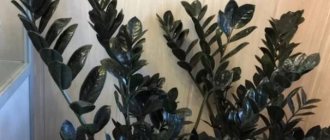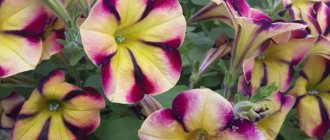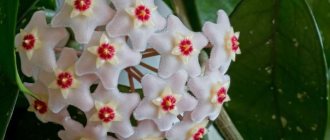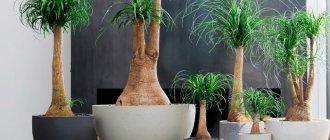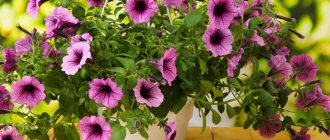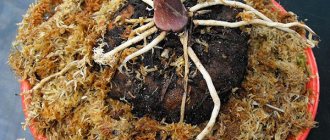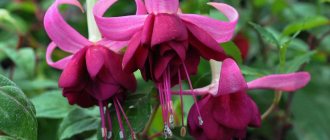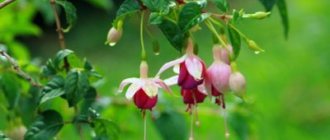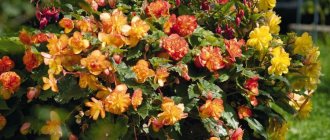Vegetative petunia blooms for a long time, is easy to care for, and looks decorative in flower pots and flowerpots all season long. The varieties are striking in the color of their petals: from snow-white to deep black tones, terry and contrasting, with strokes and stripes. In this article I will talk about why gardeners love vegetative petunia so much, which varieties are the most spectacular and attractive, what are the features in its cultivation, and how to properly preserve cuttings.
Starry sky
Petunia Night Sky
Several new hybrids have very interesting colors, reminiscent of a starry sky. The German ampelous variety of petunia Night Sky, which received the FleuroStar Award in 2015, is distinguished by a unique spotted flower pattern; white spots are chaotically scattered on a blue-lavender background, as if the artist had splashed paint from his brush. This variety is accompanied by Bonnie Mystery Sky with very small bright spots on a dark blue background.
Czech hybrids of the Dot Star F1 series have a similar coloration. They are available in two versions - deep pink - Deep Pink and purple color - Dark Violet.
Petunia Dot Star Deep Pink F1
The pattern of each flower with a diameter of 6-7 cm is individual; the shape and number of spots change depending on weather conditions. The height of the plants is 30-35 cm, they branch well, bloom profusely and for a long time, perfect for a flower bed, flowerpot, hanging basket or balcony box. The creators of the hybrids claim that the plants quickly restore their appearance after heavy rains and abundant watering.
Sowing seeds
Seeds of ampelous petunia Craisitunia are grown by breeders. In everyday life, rarely does anyone manage to collect them from their own flower garden, so they reproduce mainly by cuttings. After purchasing seeds, they are sown with a reserve. This is explained by the lack of natural light, on which the germination of seedlings depends.
In addition to light, seeds need sufficient moisture and soil acidity. The latter indicator should be in the range of 5.5-7.0 pH. Otherwise, the seeds will not germinate well, and the seedlings will be very weak and painful.
Vermiculite (or perlite) should be added to the soil before sowing. They will make it more nutritious and more breathable. Vermicompost, which can also be mixed into the soil with sand, serves as a leavening agent.
If you cannot prepare the soil yourself, you should buy ready-made soil mixtures for growing petunias or ready-made seedlings in pots at a flower shop.
24 hours before sowing the seeds, drainage must be organized in the container. Prepared soil is poured on top and compacted slightly. It is advisable to sift the top layer (up to 10 mm), level it, moisten it, and only then sow the seed.
There is no need to bury it (otherwise it simply won’t germinate); the seed is placed on the surface of the earth (substrate), evenly distributed over the entire surface (this can be done with a simple toothpick). The containers are covered with cellophane or glass on top. Maintain until seedlings appear at a temperature of +20-25 degrees, regularly monitoring the level of humidity and lighting.
Solar coloring
Petunia Easy Wave F1 Yellow
Pure yellow flower color is rare in petunias; more often it is cream, and bicolor varieties with bright yellow stripes also appear. However, you can find a suitable specimen in the famous series of hybrid petunia Easy Wave F1. Hybrid Easy Wave F1 Yellow is distinguished by simple pale yellow flowers with a richer golden yellow color in the throat. If you want to add sunny shades to a flower garden or container, it is better to plant a relative of petunia - calibrachoa; it is the varieties and hybrids of this species that have the brightest yellow and orange colors.
Reviews
Marina O. “I love petunia, even though I’ve been growing it not so long ago. I have several varieties growing. The most beautiful one is ampelous. It requires some maintenance, but guys, it’s worth it!”
Svetlana N. “I agree, the flower is truly incomparable. There were no problems with leaving. It was much harder for me to choose a variety; I also settled on several types. Ampelous in a flowerpot – super.”
Andrey F. “I’m not such a pro in floriculture, but I didn’t have any problems with petunia. Although many people believe that the plant is capricious, if it is cared for incorrectly or inadequately, it gets sick and dies. The main thing is not to forget to water, feed, prune if necessary, and that’s all. It will definitely thank you with lush flowering.”
Fine mesh
Petunia Daddy Blue F1
The mesh pattern gives the flowers extraordinary sophistication; for example, the variety from the Daddy Blue F1 series has dark blue, contrasting veins visible on a lilac-blue background. This American series of hybrid petunia also has other delicate colors - Pink, Red, Sugar, Orchid, Peppermint, which combine harmoniously when planted together. The plants are distinguished by very large flowers with a diameter of 8-10 cm, they branch well; to obtain a lush bush, the shoots should be pinched. Recommended for planting in balcony boxes.
Pirouette Rose F1 (Pirouette rose F1)
If you need petunia for balconies or a small flower bed, then pay attention to the hybrid petunia Pirouette rose F1. The compact bush reaches a height of only 12-15 cm, while forming long - up to 35-45 cm - side shoots. The leaves of the plant are small. They are almost invisible under the cap of dense flowers with corrugated petals, with which each bush is strewn.
The flowers are large, reaching 10-13 cm in diameter. The center of the flower is pink, and there is a white border along the wavy edge.
Petunia Pirouette rose F1 is an early flowering plant: the first flowers appear on the bush in early May. With proper care, flowering lasts until frost.
Bright stripes
Bicolor petunias are not rare; breeders create varieties with white spots along the edge of the corolla or rays diverging from the center. New items amaze the imagination with unusual color combinations.
The variety from the Amore – Fiesta series is very impressive; vertical yellow and dark red stripes create a pattern in such a way that on each corolla you see five bright hearts. The purple "hearts" contrast with the yellow central star. The plant is 30 cm tall, suitable for pots and hanging baskets, weather-resistant and restores its spectacular appearance even after heavy rain.
Petunia Amore Fiesta
The Crazytunia series is unique in its colors and patterns. One of the varieties - Pulse - combines rich dark purple, cherry and yellow colors. Compact bush with a height and diameter of about 30 cm for balcony boxes, flowerpots and flower beds.
Petunia Crazytunia Pulse
The Mystical series features a fantastic two-tone color scheme. With a compact crown, the Phantom variety is an eye-catcher with a black velvet flower background with a bright yellow star-shaped center.
Petunia Mystical Phantom
In the coming season, breeders promise to release a terry version of this variety for sale.
What does vegetative petunia mean?
Is your petunia vegetative or from seeds? A couple of years ago such a question seemed unusual, but now vegetative petunia is increasingly winning the hearts of gardeners.
Vegetative petunia is propagated by cuttings . It does not form seeds. If this happens in rare cases, then the seedlings do not repeat the maternal characteristics.
Photo: Sweetunia Burgundy Touch and Burgundy Gem
Features of vegetative petunia
In addition to interesting varieties, vegetative petunia is distinguished by stronger stems and long flowering, simplicity and unpretentiousness in care, and high decorativeness.
- Long continuous flowering
In my garden in the Moscow region, ordinary petunia from seeds in hanging flowerpots is decorative for no more than 1.5 months. I usually sow it in 2 stages with an interval of 1 month, so that pots with petunia decorate the house throughout the entire season, and not just its first half.
Last season, in all hanging pots with a volume of 5 liters, I planted 2 bushes of vegetative petunia. Blooming “clouds” delighted me from June to October.
- Easy to grow
Vegetative petunia is easy to care for, which explains its fantastic popularity among the familiar seed petunia.
- Since seeds are not formed, there is no need to constantly remove faded flowers. The plant cleans itself, which saves a lot of time.
- More stocky, does not stretch out and tolerates a small volume of planting container, which gives the gardener real pleasure.
- Plants have minimal requirements for fertilizing; with their complete absence and regular watering, they will bloom well.
- If you want luxurious flowering, feed with complex flower fertilizer every 1.5 weeks.
— Highly decorative
- It is distinguished by the dense texture of its petals, thanks to which it retains its attractive appearance even after rains.
- The length of the shoots is no more than 40 cm, so compositions with it are always compact, spherical in shape.
- It does not waste energy on the formation of numerous seeds, extending its flowering period.
Pros of growing
- It does not form seeds, which means it does not require regular pruning.
- It is not susceptible to powdery mildew, which means it does not require preventive treatments.
- Does not stretch and does not need pinching. After the cuttings take root, the plant begins to branch evenly and forms a charming flowering ball without the help of a gardener.
Photo: Crazytunia Berry Frappe and Ultra Violet
Splendor and aroma
Petunia Tumbelina Priscilla
The hybrid Atkins petunia Tumbelina Priscilla was created by English breeders and is quite resistant to the vicissitudes of the weather; the elastic flowers are not damaged by rain. All petals have contrasting veins, the central ones are strongly curled and form a lush flower of a delicate lilac color. The height of the plant is 30-35 cm, the shoots hang spectacularly from baskets and flowerpots. The magnificent flowers have a delicate aroma, which is rare among modern petunia varieties.
Cascadias Rim Magenta
The variety Cascadias Rome Magenta belongs to the cascading (ampeloid) types of petunias. The plant produces long (about 50-60 cm) strong shoots in large quantities and in a short time, turning into a very dense bush. In its central part, the stems are directed predominantly upward, and along the edges they deviate to the sides. To get a rounded bush, the plant must be trimmed properly and pinched regularly.
During the flowering period, Petunia Cascadias Rome Magenta is completely strewn with a carpet of purple-cherry flowers, emitting a subtle, pleasant aroma. Along the edge of each flower there is a clearly defined pale lemon border. The bush blooms all summer and lasts until mid-September (with good care and suitable weather conditions - until early October). The plant tolerates rain and wind well and is not afraid of cold weather: an adult bush can withstand temperatures down to –2°C.
A little mystery
Petunia Crazytunia Black Mamba. Photo by the author
The black color of flowers always attracts attention, as it is quite rare. In reality it is not pure black, but dark purple, like the Crazytunia Black Mamba.
The rich dark color goes well with any colors and sets them off. A composition in black and blue colors will look mysterious and gloomy, black and white - stylish and strict, black and red - solemn and elegant. The variety is distinguished by large velvety flowers, resistant to adverse weather conditions, a compact bush about 30 cm high, it can be planted in a flower garden, flowerpot or hanging basket.
Use the main achievement of modern petunia breeding - an extraordinary variety of colors, and your flower garden will never be boring.
How to save cuttings of vegetative petunia
Vegetative petunia lives for about three years, during which it delights with its continuous flowering. During this period, it can be regularly cut. If the plant needs to be preserved, then cuttings begin in the second half of summer.
They purchase plants from garden stores or greenhouse complexes, where they have been propagating queen cells since February. Mother plants are best preserved in special winter greenhouses, or on a cool balcony or terrace.
How to root cuttings at home
- In an ordinary apartment, dry air and high temperatures have a negative effect, and only in rare cases can bushes be kept in winter.
- However, there are some tricks to preserve the plant you like.
- Cuttings of such petunia begin in July; in the summer months it has a better chance of taking root than in the fall.
- Cuttings are rooted using peat tablets and a greenhouse. Greenhouses with cuttings are placed in the house; in a greenhouse, plants that have not yet taken root can burn.
- From about mid-September, rooted cuttings along with peat tablets are transferred into small 50 ml cups and placed under lamps.
— If the plants begin to stretch, they are cut again or pinched if a lot of planting material is not needed. Cuttings of vegetative petunia are easier to preserve than the mother plant.
— If it is not possible to store cuttings and queen cells, vegetative petunia is purchased annually in stores. Such bushes, as a rule, already have buds, and quickly begin to grow and begin to bush evenly.
Bicola F2 (Bicola F2)
Another two-color petunia looks unusual - the Bicol F2 hybrid. Refers to ampelous plants. The central shoots of the bush grow upward, but most of the eyelashes take on a lowered shape as they grow. The longest hanging shoots grow up to 30-45 cm in length. This hybrid is great for decorating flower beds, as well as for growing in hanging pots and baskets.
Possible problems in growing
Dipladenia is a tender plant. It is attacked by pests of ornamental crops: aphids, mites, scale insects. They spread very quickly in dry air. They feed on the juice of the vine, and this is how they harm it.
When colonies of pests are noticed, they are removed mechanically, with a soap solution or insecticides.
From waterlogging and stagnant air, fungal diseases appear and rot begins. The problem is solved by restoring the irrigation regime.
Other common problems and their solutions:
- The leaves are curling - dry air, you need to moisturize.
- The leaf turns yellow, the crown falls off - the temperature is incorrect, that is, it is too cold or hot.
- The leaves turn pale, the flowers fall off - there is not enough light.
- Growth has slowed down - there is not enough fertilizing.
Mandevilla in the home greenhouse
